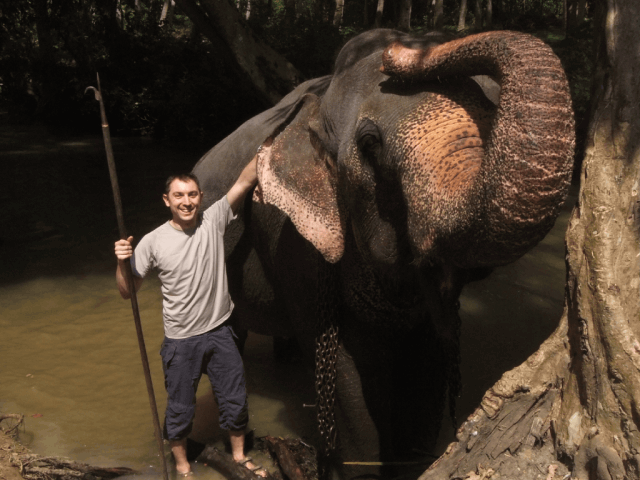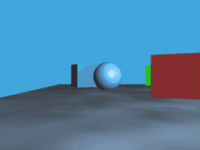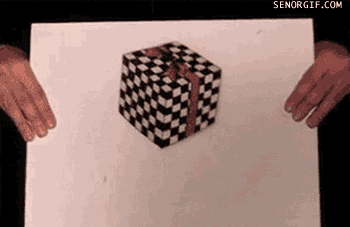Now everyone is starting to realize that stereoscopy (S3D) is cool. Of course big companies are hoping to set a new trend to get more of our money, and the film industry looks at it as if it was the new messiah.
And of course I’m really happy to see this trend rising, this helps me explain my job to my family (“See Avatar? I’m doing that but you can also interact.”).
What’s even more cool is that you can now play S3D games. That’s really interesting, but for me it’s only the first step towards real VR games, and maybe not even a necessary one! We’re not there yet, even with Natal, the PS3 Move or the Wiimote, but we’re on the Starway to VR heaven (c).
But what is really stereoscopy useful for ?
“To perceive depth, dumbass!”
Yeah true, but a one-eyed person can still perceive depth, so stereoscopy is not the only cue to achieve this. And in reality, stereoscopy is not always the best cue; for example it is only relevant for distances up to a few meters.
– Motion parallax, shadows, occlusion, perspective … –
Parallax, the apparent displacement of objects when you move, is another very important cue. Objects close to your eye move faster than objects that are far. And according to Laure Leroy’s PhD thesis (Mines ParisTech, “Interfaçage visuel stéréoscopique : diminution de la fatigue visuelle et caractérisation de la perception des formes“), motion parallax (with head tracking) is at least, if not more, important than stereoscopy ! (Thank you Alexis!)
Monoscopic cues (perspective, atmospheric artifacts (fog), relative sizes, occlusion, parallax, shadows), and stereoscopic cues (eye accomodation and convergence angle, disparity between left and right images) are all very important depth cues. ( “Le traité de la réalité virtuelle” has a very good chapter on depth perception in its first volume, chapter 3.2.3 [3rd edition])
(It’s interesting to note that monoscopic cues are learnt, it’s a cognitive activity, whereas stereoscopy is also a neurological activity.)
Look at these videos, you perceive depth but your screen doesn’t show stereoscopy ! Parallax in action :
[youtube]http://www.youtube.com/watch?v=Jd3-eiid-Uw[/youtube] [youtube]http://www.youtube.com/watch?v=89OoXyuxTLM[/youtube] [youtube]http://www.youtube.com/watch?v=ixqttxODnmE[/youtube]The most striking example I have is from my own experience. One day I made a demo in our Cave, where you seat inside a car. While quickly setuping the demo, I didn’t realize that stereoscopy wasn’t enabled. Motion parallax induced by headtracking only was enough to give me a very good sense of depth. Then the whole group of people from the demo tried the car interior and nobody told anything about stereoscopy being disabled. I guess they probably didn’t notice.
Only after David asked me : “Did you realize stereoscopy was off?”. No, I hadn’t ! I then returned to the Cave to understand how I could get fooled. So I switched stereoscopy on and off continuously for 5 minutes. Of course when you know it you see the difference. The distances and objects size seem weird. But I felt very present anyway ! ( Last week I had my stereoscopic capabilities check and their perfect, so it’s not just my eyes!). The fact that is was a car interior, with all objects pretty close is also probably a major factor. We tried on outdoor scenes and the result was much less convincing.

– Made in Sri Lanka with the Fuji Finepix Real 3D W1 and StereoPhoto maker –
Also I think people are not yet used to see stereoscopy on a screen. One day at Laval Virtual a stereoscopic movie was shown every 15 mins and the whole first day the left and right eyes were reversed. Nobody noticed or dared to say a word.
The same happens when you have somebody wear a HMD: they won’t know if stereoscopy is on or off. Only if you turn it on they will notice the difference.
What does this all mean ? Stereoscopy can be expensive to get. If your application doesn’t require precise size or distance evaluation, you can try to just use head tracking without stereoscopy, it might be more than enough !
If your application requires distance or size evaluation, stereoscopy is probably required. Also know that it’s very hard to evaluate an absolute depth, but stereoscopy is very useful to evaluate a very small difference of depth. When seeing an object from 1m, we can perceive a 1mm depth difference. At 10m, we can only perceive a 10cm difference !
On a cinema or movie screen you cannot have head tracking for a lot of people so stereoscopy is a very good addition to perceive depth and improve immersion.
For VR games I’d first go with head tracking, but of course if you can get both .. 🙂



Thanks, great run through the differences 🙂
Certainly, I can see the arguments of stereoscopy when working with engineering…for verifying small tolerances and sensing overlaps.
By the way TrackIR – is pretty the best solution on the market for precise desktop head-tracking.
Community of flight-simmers enjoy it quite a long time, check this video for example:
http://www.youtube.com/watch?v=O7Tvrp5nNR8
Actually parallax effect is very strong here.
I have one, and it’s really accurate.
It’s became a standard for flight-sims and racing, however other game-genres almost have no support for such device.
nice article !
More information on limits of stereoscopic rendering on Stereoscopic Displays & Applications website (stereoscopic.org). You can also have a look at Laure Leroy’s PhD defense (in French) about the shape perception in virtual environments and reducing visual discomfort in stereoscopic rendering.
@RasmuJ: Thank you!
@Maxim : I wouldn’t say TrackIR is accurate position wise.. I’ve made some measurements and it’s far from giving accurate positions, it’s not even a linear distortion ! the distortion also depends on the depth of the head .. It’s nice when you don’t need a precise positon, but not usable as-is for some ‘real’ headtracking where your screen looks like a window to another world. I don’t know about the priecision of orientation though.
@Guillaume : Thank you ! Here’s the link to Laure’s thesis : http://paristech.bib.rilk.com/5882/
Thanx, though I was one of Laure’s supervisors, I didn’t know her thesis was already online 🙁
I’ve used TrackIR5, with 3-LED vector. Maybe you’ve used some older one? Because people often told about errors in 3 and 4 versions. As far as I know they improve precision in 5 version greatly.
Linearity in measurements can be setup from they’re software. By default it’s nonlinear, because most games use it as nonlinear.
But sure, for big distances user must use other solution. TrackIR nice for desktop gaming, sitting on the chair 🙂
And yes, thanks for the article! 🙂
As a basic user, I do feel there is a big difference in stereoscopy, depending on if the object is behind or ahead of the screen.
behind the screen : it’s like you say, the sensation could be the same using only parallax
ahead of the screen : we really can feel if it is activated or not. Anyway, I’m not sure it’s possible to use parallax for objects ahead of the screen ?
Sebastian, here is a neuroscientists account on how Stereoscopics is far superior to parallax with a lower threshold, what do you think of the claims of the medical people below?
http://bsandrew.blogspot.com/2012/03/how-hugo-gave-one-neuroscientist-gift_630.html
Thank you for the interesting article!
I’m not a researcher myself so I can only report on others’ work.
The article doesn’t not state that stereopsis is far superior, just that it is more precise.
And indeed stereoscopy will give you more precise information about depth, distances and volumes.
It’s just that it may not be necessary in all conditions, and parallax can be easier to get that stereoscopy. Stereoscopy requires more computing resources and specific hardware.
Michael Abrash and John Carmack said that they would happilly trade stereoscopy for motion parallax here : http://www.youtube.com/watch?v=8gaqQdyfAz8&feature=youtu.be
It’s not a case against stereoscopy, and of course it’s much better to have both sterescopy and parallax. It’s just that stereoscopy is not everything in depth perception 🙂